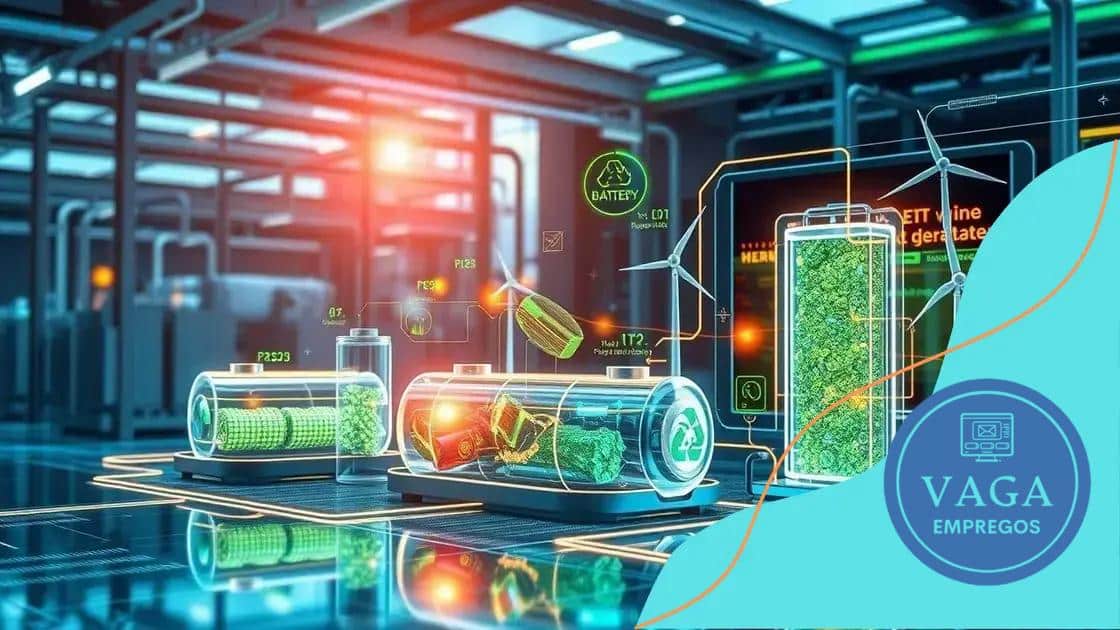Breakthroughs in clean battery tech attract global interest

Advertisement
Breakthroughs in clean battery technology are driving sustainable energy solutions by addressing challenges such as resource scarcity, high manufacturing costs, and environmental impacts, ultimately enhancing energy storage efficiency and reliability.
Breakthroughs in clean battery tech are capturing the attention of innovators worldwide. With the push for sustainable energy, understanding these advancements is crucial. What does this mean for our future?
Advertisement
The evolution of clean battery technologies
The evolution of clean battery technologies has been astounding over the past few years. With the global shift towards sustainability, these advancements are essential for a cleaner future. Let’s explore how these technologies have transformed from basic designs into innovative solutions.
Advertisement
Historical Background
Initially, batteries were primarily lead-acid based, which posed significant environmental challenges. However, as technology progressed, manufacturers began to explore alternatives. Innovations like lithium-ion batteries revolutionized the landscape, providing higher efficiency and less environmental impact.
Current Technologies
Today, numerous clean battery technologies are under development, including:
- Solid-state batteries that provide improved safety and longevity.
- Flow batteries which offer versatility in various applications.
- Recyclable batteries focusing on reducing waste and promoting sustainability.
Continuing from this, researchers are also looking into bio-based batteries, which harness natural materials. These options promise to minimize toxic components while maximizing efficiency. As we move forward, the integration of renewable energy sources will further enhance the functionality of these batteries.
Another crucial development is the rise of manufacturing processes that prioritize eco-friendliness. Companies are now investing in facilities that use green energy, significantly reducing the carbon footprint associated with battery production. This shift reflects a broader commitment to sustainability across industries.
Key players in clean battery innovation
When discussing the future of clean battery innovation, it’s essential to highlight the key players driving these advancements. Various companies, research institutions, and even governments are investing in and prioritizing clean battery technologies. Understanding who these innovators are can provide insight into the future landscape.
Leading Companies
Several major companies are at the forefront of this revolution. For instance, companies like Tesla and Panasonic have heavily focused on battery production and efficiency, while others like LG Chem and Samsung SDI are developing new materials and technologies to enhance energy storage.
Research Institutions
Universities and research centers also play a crucial role in clean battery innovation. Places like MIT and Stanford University are pioneering research on lithium-sulfur and solid-state batteries. Their breakthroughs often lead to practical applications that can be scaled up for mass production.
- University of California researchers are pushing the boundaries of battery life and efficiency.
- Fraunhofer Institute in Germany focuses on developing sustainable battery technologies.
- National Renewable Energy Laboratory in the U.S. explores the integration of batteries with renewable energy sources.
Moreover, governmental initiatives are also essential for fostering innovation in this field. Various countries are providing funding and incentives for companies developing clean battery technologies. This support helps bridge the gap between research breakthroughs and their commercialization, ensuring new ideas are brought to market.
As we consider the global landscape, collaboration among these players is vital. Partnerships between manufacturers, researchers, and governments can expedite the development and deployment of advanced battery systems. This collective effort aims to create solutions that not only meet current demands but also anticipate future needs.
Environmental impacts and sustainability
The environmental impacts of battery production and usage are significant, making sustainability a key focus within the industry. Addressing these challenges is crucial for fostering a greener future. Innovations in clean battery technologies aim to reduce the ecological footprint associated with traditional battery manufacturing.
Battery Production and Resource Extraction
Manufacturing batteries often involves extracting raw materials like lithium, cobalt, and nickel. These processes can lead to habitat destruction, water pollution, and significant carbon emissions. Efforts to enhance sustainability focus on minimizing these impacts. Companies are exploring ways to recycle materials and reduce the need for newly mined resources.
Lifecycle Analysis
A lifecycle analysis (LCA) offers insights into the environmental impacts of batteries from production to disposal. Key stages include:
- Raw material extraction and its effects on ecosystems.
- Manufacturing processes that demand high energy consumption.
- End-of-life management strategies, such as recycling or proper disposal.
Understanding this lifecycle is critical for identifying where improvements can be made. By focusing on each stage, manufacturers can enhance the sustainability of their products while minimizing negative effects.
New initiatives focus on developing batteries that are easier to recycle, such as eco-friendly designs and materials. For example, rather than relying solely on scarce elements, manufacturers are looking at sustainable alternatives. Research into biodegradable battery components also signals a promising path forward.
Lastly, the shift toward renewable energy sources amplifies the importance of sustainable battery solutions. As more solar and wind energy systems rely on energy storage, the demand for eco-friendly batteries increases. The right technology can help balance energy supply and demand, paving the way for a clean energy future.
Future trends in clean battery development

Future trends in clean battery development are shaping a new landscape for energy storage and sustainability. With growing environmental concerns and technological advancements, the focus is on creating batteries that are not only efficient but also eco-friendly.
Next-Generation Battery Technologies
Researchers are actively exploring next-generation battery technologies that promise to exceed the performance of current lithium-ion batteries. For example, solid-state batteries utilize a solid electrolyte instead of a liquid one, offering better safety and higher energy density. This could lead to lighter and longer-lasting batteries.
Recycling Innovations
As the demand for batteries increases, so does the need for effective recycling methods. Advanced recycling technologies focus on:
- Recovering valuable materials from used batteries.
- Reducing waste by reusing components.
- Creating a closed-loop system where materials are continually reused.
These innovations are crucial for minimizing the environmental impact of battery production and ensuring resources are sustainably managed.
Another emerging trend is integrating renewable energy sources with battery systems. As more homes and businesses adopt solar panels or wind turbines, the role of batteries becomes even more important. They can store excess energy produced during peak times and release it when needed, creating a more resilient energy grid.
Furthermore, advancements in artificial intelligence (AI) are finding their way into battery management systems. Smart technologies can optimize charging and discharging cycles, leading to longer battery life and improved efficiency. This combination of AI and battery technology holds great potential for the future.
Challenges facing clean battery technology
Despite the significant advancements in clean battery technology, several challenges remain that can hinder widespread adoption and innovation. These challenges need to be addressed to fully realize the potential of sustainable energy storage solutions.
Resource Scarcity
One major issue is the scarcity of essential materials used in battery production, such as lithium and cobalt. These resources are not only finite, but their extraction often involves environmentally damaging practices. Finding alternatives or improving the recycling of these materials is crucial for sustainable battery development.
Manufacturing Costs
The costs associated with producing advanced batteries remain high. While prices have dropped in recent years, further reductions are necessary for clean batteries to compete with traditional energy sources effectively. Research and development into more affordable manufacturing processes could help lower these costs.
- Investing in new technologies to make production more efficient.
- Scaling up production to reach economies of scale.
- Collaborating with partners to share resources and expertise.
Additionally, battery performance in extreme conditions, such as high temperatures or very cold climates, can affect their efficiency and lifespan. Engineers are working to create batteries that can operate efficiently under varied environmental conditions.
Moreover, consumer awareness and acceptance of clean battery technologies also pose challenges. Many people still have concerns about the safety and longevity of new types of batteries. Educational campaigns can help alleviate these concerns and promote the benefits of clean energy storage.
Regulatory hurdles can also slow progress. Navigating through a complex web of policies can be challenging for companies developing innovative solutions. Streamlining regulations and creating incentives could encourage faster adoption and innovation in the field.
FAQ – Frequently Asked Questions about Clean Battery Technology
What are clean batteries?
Clean batteries are energy storage systems designed to minimize environmental impact and use sustainable materials. They aim to provide efficient energy without harming the planet.
What challenges do clean battery technologies face?
Major challenges include resource scarcity, high manufacturing costs, performance in extreme conditions, and regulatory hurdles that can slow down innovation and adoption.
How can recycling improve sustainability in battery technology?
Recycling allows for the recovery of valuable materials from used batteries, reducing the need for new resources and minimizing waste, thereby supporting a more sustainable battery lifecycle.
Why is consumer awareness important for clean battery adoption?
Educating consumers about the benefits and safety of clean battery technologies can help alleviate concerns, spark interest, and encourage the adoption of these sustainable solutions.





